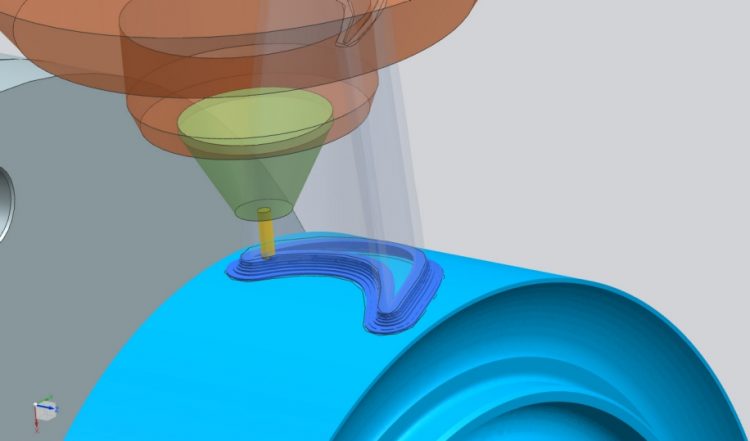New Software Combines 3D Printing with Traditional Manufacturing

Picture DMG MORI
Compared to traditional methods of work piece manufacture, 3D printing, otherwise known as additive manufacturing, makes a much wider range of shapes possible. Hybrid machine tools that combine both methods in a single manufacturing station are a relatively new concept and open up totally new production opportunities.
Siemens’ NX Hybrid Additive Manufacturing is one of the first such programs for this type of manufacturing station. At the Machine Tool World Exposition (EMO) in Milan, Italy, Siemens demonstrated its solution using a hybrid machine from DMG Mori that combines laser cladding with a multi-axis milling machine.
As an industrial user, Siemens has long favored additive manufacturing methods such as laser cladding as a means of building up metals layer by layer.
For example, the time taken to manufacture burner heads for gas turbines has been cut by up to 90 percent since it became possible to “print” them directly onto the burner body. A similar method can be used to manufacture a product in normal series production and then add on individual components by printing.
3D printing also makes entirely new shapes possible, such as honeycomb structures. And components that have previously had a solid structure can now be made hollow with relative ease to save weight.
If a high degree of precision is required, additive manufacturing methods can be combined with traditional processes. Hybrid machines that enable a work piece to be built up by adding material, followed by high-precision finishing work, are therefore an ideal solution.
Optimizing the Connection between Additive and Subtractive Steps
When it comes to additive methods, manufacturing equipment requires fundamentally different programming. For example, the paths followed by the print head are entirely different from those of a cutter head. Temperature is another key control parameter. With laser cladding, the work area is heated and metal is melted onto it.
The volume of heat applied by the print head depends on the temperature of the work piece. The longer the interval since the last processing stage, the more it will have cooled and the more laser power the print head will need to apply.
A third factor with regard to hybrid machines is that the changeover between the additive and subtractive stages must be carefully worked out, for example by ensuring that the finishing work is performed on a printed part before the parts added later make it inaccessible to the cutter.
This is why Siemens has expanded its PLM NX software for product design, production and manufacture to include the NX Hybrid Additive Manufacturing module. This software makes it possible to produce products using a combination of subtractive and additive methods, and ensures that the individual processing stages are arranged meaningfully.
It simulates the entire manufacturing process and, once it has been checked, transmits it to the machine control system. NX Hybrid Additive Manufacturing is currently configured specifically for the Lasertec 65 3D from DMG Mori and the Siemens Sinumerik 840D sl CNC control system.
Norbert Aschenbrenner
Mr. Dr. Norbert Aschenbrenner
Editorial Office
Siemens AG
norbert.aschenbrenner@siemens.com
Mr. Florian Martini
Press contact
Siemens AG
florian.martini@siemens.com
Contact us
Write us an e-mail
pof@siemens.com
Media Contact
More Information:
http://www.siemens.com/innovationAll latest news from the category: Information Technology
Here you can find a summary of innovations in the fields of information and data processing and up-to-date developments on IT equipment and hardware.
This area covers topics such as IT services, IT architectures, IT management and telecommunications.
Newest articles

Silicon Carbide Innovation Alliance to drive industrial-scale semiconductor work
Known for its ability to withstand extreme environments and high voltages, silicon carbide (SiC) is a semiconducting material made up of silicon and carbon atoms arranged into crystals that is…

New SPECT/CT technique shows impressive biomarker identification
…offers increased access for prostate cancer patients. A novel SPECT/CT acquisition method can accurately detect radiopharmaceutical biodistribution in a convenient manner for prostate cancer patients, opening the door for more…

How 3D printers can give robots a soft touch
Soft skin coverings and touch sensors have emerged as a promising feature for robots that are both safer and more intuitive for human interaction, but they are expensive and difficult…





















